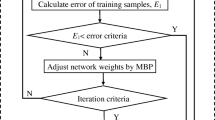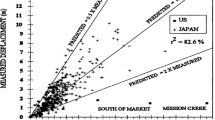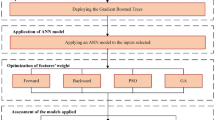Abstract
Considering the complicated monotonously increasing character of the displacement series in underground engineering, the original displacement sequence is divided into two components: the displacement trend sequence and the displacement deviation sequence. This study proposes a new, integrated intelligent method for displacement prediction in underground engineering which is the combining of the grey system method and the evolutionary neural network. The architecture and algorithmic parameters of the neural network simultaneously evolve by immunized evolutionary programming and MBP algorithm. In this method, the grey system method is used to predict the displacement trend sequence, which is one simple monotonous sequence; the evolutionary neural network is used to predict the displacement deviation sequence, which is one very complicated time series. The applications in various real underground engineering examples prove that the approximation sequence and the generalization predication sequence of the integrated intelligent method all coincide well with the measurement displacement sequence. The robustness, performance and applicability of the newly integrated intelligent method are far superior to those of the traditional method. Therefore, this method is an excellent means to predict the measurement displacements of underground engineering.












Similar content being viewed by others
References
Seki J, Okada M (1987) Adaptability of convergence forecasting method for controlling tunnel construction. In: Proceedings of 2nd international symposium on field measurements in geomechanics, pp 907–916
Kim NY, Chung HS (2002) A study on prediction of final displacement of road tunnel section during excavation in highly weathered rock by NATM. KSCE J Civ Eng 6:399–405
Zhang GM, Wu Y, Wang LJ, Zhang K, Daemen JJK, Liu W (2015) Time-dependent subsidence prediction model and influence factor analysis for underground gas storages in bedded salt formations. Eng Geol 187:156–169
Fuentes R (2015) Internal forces of underground structures from observed displacements. Tunn Undergr Space Technol 49:50–66
Zhao DP, Jia LL, Wang MN, Wang F (2016) Displacement prediction of tunnels based on a generalised Kelvin constitutive model and its application in a subsea tunnel. Tunn Undergr Space Technol 54:29–36
Chen ZY (1988) Time series analysis applied to displacement prediction in NATM. In: Proceeding of international symposium on modern mining technology (Taian 1988). Shandong Institute of Mining and Technology Press, Taian, pp 315–320
Li SC, Wang WM, Wang LC (1997) Application of non-linear time series analysis model to displacement forecasting in underground engineering. Chin J Geotech Eng 19(4):15–20 (in Chinese)
Huang ZQ, Jiang T, Yue ZQ, Lee CF, Wang SJ (2003) Deformation of the central pier of the permanent shiplock, Three Gorges Project, China: an analysis case study. Int J Rock Mech Mining Sci 40:877–892
Li XH, Zhao Y, Jin XG, Lu XY, Wang XF (2005) Application of grey majorized model in tunnel surrounding rock displacement forecasting. Lect Notes Comput Sci 3611:584–591
Xiong XB (2014) Research on grey system model and its application on displacement prediction in tunnel surrounding rock. Open Mech Eng J 8:514–518
Bizjak KF, Petkovšek B (2004) Displacement analysis of tunnel support in soft rock around a shallow highway tunnel at Golovec. Eng Geol 75:89–106
Chen YL, Azzam R, Zhang FB (2006) The displacement computation and construction pre-control of a foundation pit in Shanghai utilizing FEM and intelligent methods. Geotech Geol Eng 24:1781–1801
Mahdevari S, Torabi SR (2012) Prediction of tunnel convergence using artificial neural networks. Tunn Undergr Space Technol 28:218–228
Lai JX, Qiu JL, Feng ZH, Chen JX, Fan HB (2016) Prediction of soil deformation in tunnelling using artificial neural networks. Comput Intell Neurosci 2016:1–16, Article ID 6708183
Mahdevari S, Torabi SR, Monjezi M (2012) Application of artificial intelligence algorithms in predicting tunnel convergence to avoid TBM jamming phenomenon. Int J Rock Mech Mining Sci 55:33–44
Yao JB, Yao BZ, Li L, Jiang YL (2012) Hybrid model for displacement predication of tunnel surrounding rock. Neural Netw World 3(12):263–275
Yao B, Yao J, Zhang M, Yu L (2014) Improved support vector machine regression in multi-step-ahead prediction for rock displacement surrounding a tunnel. Sci Iran A 21(4):1309–1316
Wu QD, Yan B, Zhang C, Wang L, Ning GB, Yu B (2014) Displacement prediction of tunnel surrounding rock: a comparison of support vector machine and artificial neural network. Math Probl Eng 2014:1–6, Article ID 351496
Gao W, Zheng YR (2000) Study on some displacement predicting methods for the geotechnical engineering. In: Proceeding of 6th conference of Chinese society of rock mechanics and engineering (Wuhan 2000). China Science and Technology Press, Beijing, pp 90–93 (in Chinese)
Gao W (2002) Study on the neural network model for displacement predication in the geotechnical engineering. Geotech Eng 14(1):8–12 (in Chinese)
Gao W, Yin ZX (2011) Modern intelligent bionics algorithm and its applications. Science Press, Beijing (in Chinese)
Feng XT, An HG (2004) Hybrid intelligent method optimization of a soft rock replacement scheme for a large cavern excavated in alternate hard and soft rock strata. Int J Rock Mech Mining Sci 41:655–667
Sun HR, Wang SH, Gong YJ, Zhuang SY (2001) Study on genetic-neural network method of displacement in big cavern during excavation. J China Coal Soc 26(1):45–48 (in Chinese)
Jang H, Topal E (2014) A review of soft computing technology applications in several mining problems. Appl Soft Comput 22:638–651
Chen C, Huang SJ (2013) The necessary and sufficient condition for GM(1,1) grey prediction model. Appl Math Comput 219:6152–6162
Liu SF, Yang YJ, Wu LF (2014) Grey systems—theory and applications. Science Press, Beijing (in Chinese)
Kayacan E, Ulutas B, Kaynak O (2010) Grey system theory-based models in time series prediction. Expert Syst Appl 37:1784–1789
Deng JL (1985) Grey system: society and economy. Defense Industrial Press, Beijing (in Chinese)
Fogel DB (1995) Evolutionary computation: toward a new philosophy of machine intelligence. IEEE Press, New York
Feng XT (2000) Introduction of intelligent rock mechanics. Science Press, Beijing (in Chinese)
Balestrassi PP, Popova E, Paiva AP, Marangon Lima JW (2009) Design of experiments on neural network’s training for nonlinear time series forecasting. Neurocomputing 72:1160–1178
Churing Y (1995) Backpropagation, theory, architecture and applications. Lawrence Erbaum Publishers, New York
Acknowledgements
The financial supports from The Fundamental Research Funds for the Central Universities under Grant Nos. 2014B17814, 2016B10214, 2014B07014 and B15020060 are all gratefully acknowledged.
Author information
Authors and Affiliations
Corresponding author
Rights and permissions
About this article
Cite this article
Gao, W. Integrated Intelligent Method for Displacement Prediction in Underground Engineering. Neural Process Lett 47, 1055–1075 (2018). https://doi.org/10.1007/s11063-017-9685-4
Published:
Issue Date:
DOI: https://doi.org/10.1007/s11063-017-9685-4




